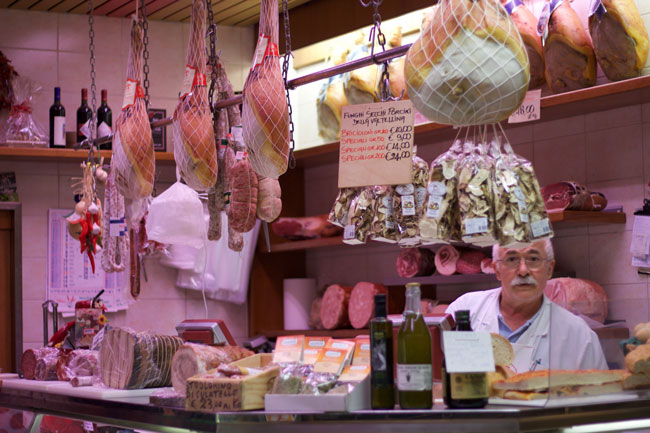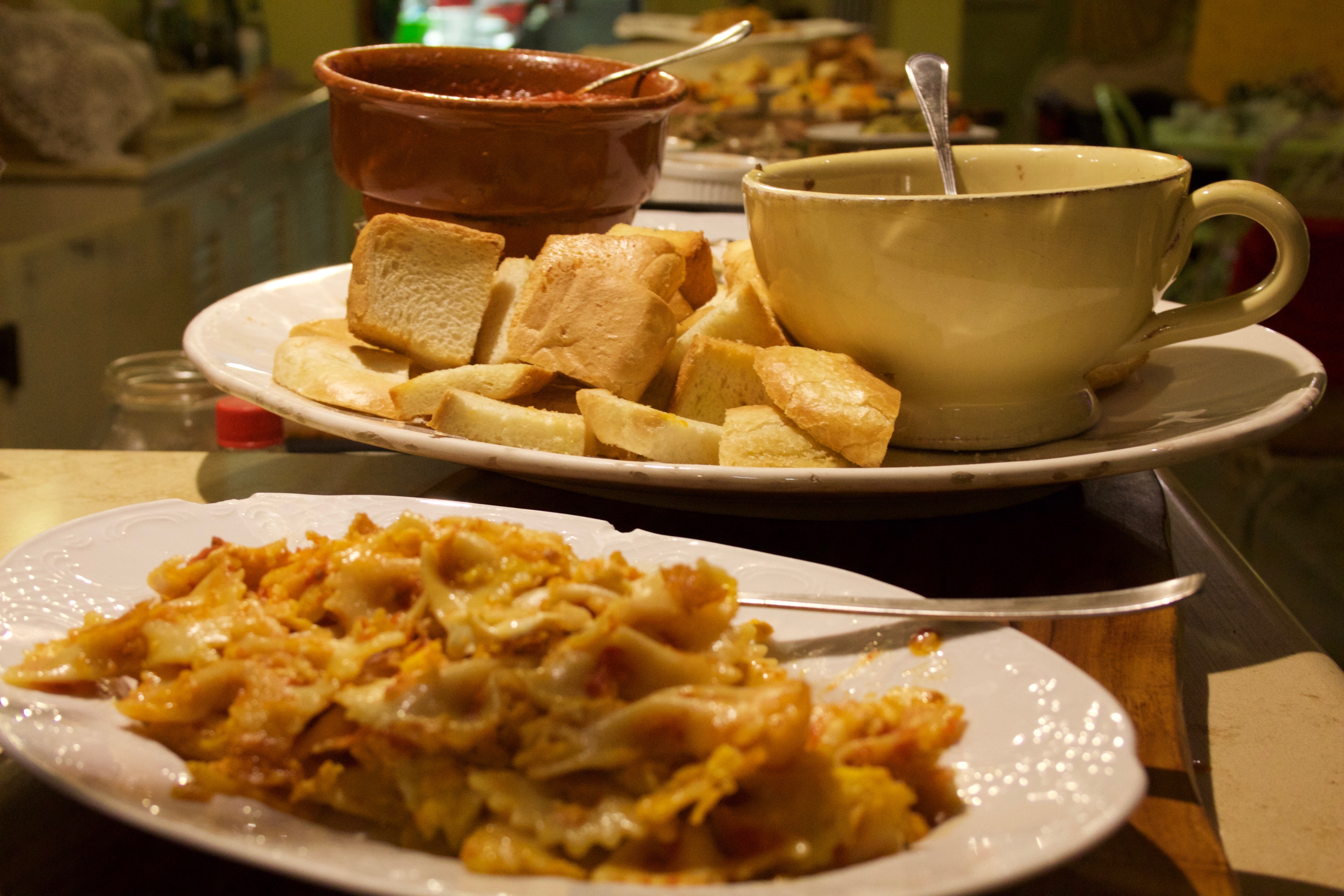As the birthplace of the world’s most famous pasta sauce, it is no surprise that Bologna is a real Italian treat. With traditional dishes and culture galore, it would be impossible not to have the food holiday of a lifetime here. I have long obsessed over Italian food, and have spent many a happy family holiday pigging out on pizza and ragu e spaghetti all over Italy. However Bologna, as well as being the home of tortellini pasta, offers so much more than your average tourist destination.
This was my second adventure to the city. A friend from Trinity graduated and moved to Bologna last year, which has led me to visit twice now, and I suspect this will not be the last trip I make to such a welcoming city. The more time I spend in the region, the more I envy her. The area has so much history in its buildings and food, yet it is so alive with its young student population.
Better known as the “Red City”, Bologna burns with its red plastered walls, red brick medieval buildings, and red blinds, and the colour certainly extends to its politics as well, as the city has always had sympathy for communist ideals. Aside from this, however, the red also offers a warmth to the bustling metropolis that still comes as a surprise. Despite being a city, with a student population greater than Dublin’s, the impressive vaulting and unique porticos give you the sense that you are in fact navigating one large palace.
Despite being a city, with a student population greater than Dublin’s, the impressive vaulting and unique porticos give you the sense that you are in fact navigating one large palace
These porticos are unique to the city and surrounding towns. They provide shelter from the sun in summer, and from rain and snow during winter. Their mosaic tiled floors are usually home to roast chestnut stands, whose slightly caramelised kernels provide the most wonderful aroma in the cold weather, or the tables and chairs of the numerous bustling bars lining the tiles. These bars serve as cafes by day, serving coffee and sweet treats, and bars by night.
Another feature of the city that is unmissable as you walk down the main street are the two towers of Bologna, named Garisenda and Asinelli. These medieval towers have stood the test of time, and have become part of myth and legend. Garisenda is unfortunately missing its top after having had to be lowered due to its dangerous leaning. One of the spellbinding optical illusions I’ve come across is to stand behind this tower and stare up, giving you the feeling that it will suddenly come down and crush you flat. It’s a visual trick that’s entered even literature, as Dante said in his epic poem, “Inferno”: “As when one sees the tower called Garisenda from underneath its leaning side, and then a cloud passes over and it seems to lean the more, thus did Antaeus seem to my fixed gaze as I watched him bend.”
Most Trinity students are aware of the myth that walking under the campanile in Front Square risks you failing your undergraduate exams. A similar myth exists in Bologna, one which says that any student who climbs to the top of the Asinelli tower will fail their exams. Thanks to these two towers, it is impossible to get lost within the old walls of the city, as every road and street in the city lead back to them. An excellent feature for those who lack a sense of direction like my friend, or are more of a nervous traveller like myself.

One of the key evening activities of the local population is to indulge in aperitivo or appetisers. This typically consists of going out in the city and finding a bar and eating fine cheeses and local meats, cold pastas, paté, crostini, all served with traditional Bolognese bread (a sourdough bread made with pancetta and ham) and either a glass of wine or a spritz – a regional wine-based cocktail. The town’s nightlife, which is still busy for most of the week, properly comes alive at the weekends, particularly Sunday nights, when the biggest crowds descend on the city from the surrounding region. Aperitivo, depending on how much you eat, can set you back between €8 and €15 per person. A board of olives, meats, and cheese, and a side order of focaccia with ricotta and two glasses of Lambrusco, the local sparkling rosé, cost €23 for two people, including a complimentary basket of Bolognese bread.
Myself and my friend decided to eat on the old fishmongers street, Via Pescherie Vecchie, a bustling narrow alley of bars and food shops just off the main square, Piazza Maggiore. We chose the first place that had a table, as sometimes you could end up waiting 10 minutes for one to be free in the most popular parts of the city. The cold November air didn’t put us off sitting outside as there were an abundance of heaters, and the packed street of loud laughing locals added to the warmth.
For the cost of only €7 per person, you get access to an all-you-can-eat buffet of pastas, breads, cheeses, hams, salamis, and salads, with a spritz included
The cheeses on the board included a Sicilian pecorino, or hard sheep’s cheese, matured in hay. This was my favourite, although my friend preferred the 18-month aged Parmigiano-Reggiano, better known as Parmesan. The third cheese on offer was another sheep milk cheese aged with saffron and black pepper corns. The meats on offer included, of course, ridiculously thin slices of Parma ham, which was a personal favourite. The three other meats included a traditional salame picante – pepperoni – and a ham that put the best of Irish hams to shame.
In Bologna, aperitivo has been adopted by the large student population. Traditionally it was something you would do in the evening before dinner, but in recent years, and with this growing student influence, Bologna has seen the aperitivo evolve in certain areas of the city into apericena, or dinner. For the cost of only €7 per person, you get access to an all-you-can-eat buffet of pastas, breads, cheeses, hams, salamis, and salads, with a spritz included.
Some smaller squares of the city are closed off during weekend evenings to facilitate this. A bar, tables and chairs are set up in the centre of the square and the delicious buffet laid out inside the bar. Travellers must beware, however, that all alcoholic drinks in Bologna have a bite to them: they are not mean with the alcohol and don’t bother masking the flavour with sugar. Cocktails, beer and wine vary in price across the city depending on the bar, but usually fall between €3 and €10.
My friend and I decided to go out for aperitivo again during my stay. This lead us to Opera Caffé e Tulipani, an eclectic and quaint bar, run by a beautiful and friendly lady. They served the traditional spritz, wine, or cocktails, so I treated myself to a martini. A balcony at the back of the bar looks down into the Reno river that runs through the city, while inside the walls are covered in jazz and celebrity memorabilia and interesting pieces of art. If that wasn’t glam enough for you, a baby grand piano sits snugly at the corner of the bar.

The aperitivo served here was delicious, with butternut squash butter, paté, red pepper relish and beautiful cheesy pasta just some of the delights on offer. Like most places, you grab a plate and eat as much as you want. The lady didn’t charge us for the food, but drinks were on the more expensive side, with my martini coming to €8.
It would be sacrilege to visit Italy without eating pizza. Pizza in Bologna is not as popular as the tasty, native, pork-filled tortellini, but the city is fortunate to be home to a pizzeria called Spacca Napoli on Via San Vitale. In all my Italian travels I have never tasted pizza so good. The pizzas here are bigger than the plate they come out on, and won’t set you back more than €10. You can taste the freshness in the ingredients, all sourced locally: the sweet tomato sauce, the creamy mozzarella, the thin slices of salame picante. Ordering pepperoni in Italy will get you delicious roast red peppers on your pizza rather than salame picante. The challenge in this restaurant is to finish the pizza, which I failed.
The streets of Bologna are lined with typical high street and boutique clothing stores, numerous ice cream shops, cute homeware stores, and, of course, bars. Sitting out enjoying a macchiato or cappuccino on a lazy Sunday afternoon with a friend is as blissful as it sounds. Most bars offer delicious, indulgent treats, from custard-filled croissants and big doughnuts to simple biscotti. The most a coffee should set you back is €2, and that would be considered expensive. Even better, every restaurant and cafe has a service charge included in the price, so tipping isn’t necessary when you’re in the throes of a food coma.
Another key feature of Bologna’s streets is the numerous green grocers, their shop fronts stacked high with the season’s freshest
Another key feature of Bologna’s streets is the numerous green grocers, their shop fronts stacked high with the season’s freshest. November brings oranges, plums, pomegranates, and kaki – also known as persimmons or Sharon fruit. However, on the main promenade of the city, down a covered alley, and up three steps, is the city’s main all-year-round indoor food market. The vibrant stalls of fruit and veg are accompanied by butcher’s counters, cheese counters, and fishmongers. Most of these stalls, and the local grocers, stay open late into the evening.
The Bolognese population love their dolce, particularly waffles, crepes, and doughnuts. The city is home to a little dessert shop called Bombo Crep, on Via delle Moline, which serves the popular Italian pastry called the bombolone. For just €2 you can get this fried, brioche-style delight stuffed with nutella and mascarpone, or other indulgent flavours of your choosing, including créme patissiere, fresh fruit and melted dark chocolate. This shop opens until 3:30am most nights, and delivers to the surrounding area, making it extremely popular with the students of the city. It is also strategically placed close to Piazza Verdi where some students would, let’s say, get the munchies, and appreciate the proximity of the shop’s cheap delights.
Bologna is such a splendid and beautiful city, and I fall more in love each time I visit. Walking down the main street at night looking up at the buildings all around, it is hard not to be impressed by the architecture, uniqueness and the charm of the ancient city that has managed over centuries to become an enduringly exciting student haven.







